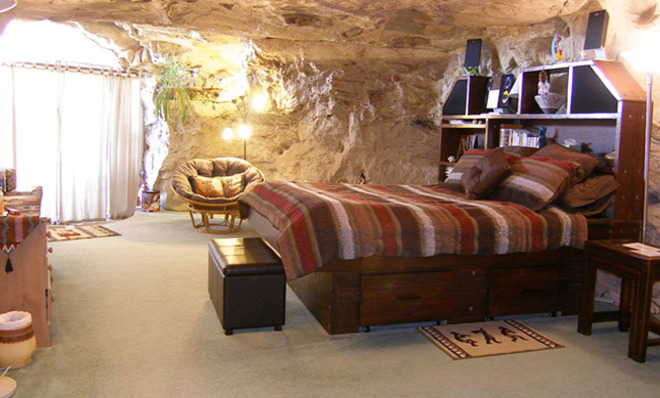How to turn a 65-million-year-old sandstone cliff into a hotel
And seven other innovative hotel designs


Any old billion-dollar conglomerate can build a regular hotel, with boring hallways leading to cookie-cutter rooms, flat walls, and unified basic amenities. But it takes a dab of genius to repurpose an entirely different structure, one intended to serve a distinct non-hospitality-related purpose, into a hotel. Here are eight examples of such ingenuity.
1. Abbey Road Farm; Carleton, Oregon
Original purpose: Grain silos
The Week
Escape your echo chamber. Get the facts behind the news, plus analysis from multiple perspectives.

Sign up for The Week's Free Newsletters
From our morning news briefing to a weekly Good News Newsletter, get the best of The Week delivered directly to your inbox.
From our morning news briefing to a weekly Good News Newsletter, get the best of The Week delivered directly to your inbox.
(Abbey Road Farm Bed & Breakfast/Facebook.com)
When John and Judi Stuart bought the 82-acre horse farm on which their B&B now sits, it came with grain silos. But since the couple were 30-year veterans of the insurance business — and not, you know, farmers — they didn't know what to do with the silos. Out of that confusion came a highly regarded bed and breakfast with five unique guest rooms. The two outer silos each contain two fully modern rooms, upstairs and down; while the center silo uses its bottom floor as a sitting room. The farm is a functioning one, and supplies the ingredients for the homemade breakfasts offered at the inn.
2. The Majestic Bus; Herefordshire, UK
Original purpose: Bus
A free daily email with the biggest news stories of the day – and the best features from TheWeek.com
(Majestic bus/Facebook.com)
The remodeling of this bus created a compact, bright, and clean space that sleeps four, has a wood-burning heat stove, and a gas cooktop. Tiny details of the 1960s bus design are still visible all over, from the steering wheel to the route indicator ("Private"). The toilet and bath are located a short distance away in a specially built little bungalow.
3. Shack Up Inn; Clarksdale, Mississippi
Original purpose: Cotton plantation
(The Shack Up Inn/Facebook.com)
The owners of the Shack Up Inn (which is actually more of a compound of Hillbilly Cool) want you to be aware of a couple things. First of all, it's all about the music. Second, "The Ritz we ain't." The buildings offered for your slumber are extremely historically accurate and have been updated just enough to be considered humane by 21st century standards (toilets, air conditioning, etc.) And finally, those buildings aren't old slave quarters, they're old share-cropper cabins. The Inn is located on what used to be the Hopson Plantation; the first plantation to plant, grow, and harvest cotton entirely by machine, heralding the end of share-cropping and plantations in general.
4. Kokopelli's Cave; Farmington, New Mexico
Original purpose: 65-million-year-old sandstone cliff
When engineers originally begin blasting out space inside the rock face of an Ojo Alamo sandstone cliff, it was to make an office for geographic consultant Bruce Black. Instead, it became a one-room bed and breakfast 70 feet below ground. The different areas of the cave; fully functional bathroom, kitchen, bedroom, and living area are centered around a large pillar of stone in the center of the cave. Carpet, electricity, and plumbing are all standard, and the bedroom includes a window allowing views from the side of the cliff.
5. Spitbank Fort; English Channel off Portsmouth, England
Original purpose: 19th-century sea fort
(Spitbank Fort/Facebook.com)
If you intended harm toward England in the mid-19th century, and your steam-powered ships somehow allowed you to squeeze past the first two military forts guarding the valuable docks of Portsmouth, you would still have to deal with Spitbank. Built by the British in 1867, Spitbank was one of four heavily-armed forts meant to keep enemies (the French) from reaching England. These forts were all but useless by WWII, unable to support contemporary warcraft. The British Ministry of Defense put the forts up for sale in the 1960s. In the '80s, they were bought by the company AmaZing Venues, and Spitbank was converted into a luxury resort. The nine suites still have brick-and-mortar walls, but nearly every other amenity you can imagine replaces the soldiers and armaments that once defended Britannia.
6. The Old Mount Gambier Gaol; Mount Gambier, Australia
Original purpose: Prison
(The Old Mount Gambier Gaol/Facebook.com)
Here, you can choose affordable rooms that are barely altered from the building's 109-year tenure as a jail; bunk beds, bars on the doors, and shared toilets. The Gaol also offers more modern, cozy rooms, and even a three-bedroom "Warden's Cottage" for those who don't need the completely authentic prison experience.
7. Hotel de Vrouwe van Stavoren; Stavoren, Netherlands
Original purpose: Wine cask
(Hotel de Vrouwe van Stavoren/Facebook.com)
The Hotel de Vrouwe van Stavoren sits near the port of what was once an extremely busy shipping town, and is now a popular leisure destination. But what makes the hotel famous are the rooms they built from the four giant wine casks they had shipped from Switzerland. Each vat holds little more than twin beds and what I can only imagine is an aroma that will inspire the sweetest dreams for wine lovers. Attached to the back of each cask is a sitting room with modern amenities.
8. Hillside Schoolhouse; Barryville, New York
Original purpose: One-room schoolhouse.
(Hillside Schoolhouse/Facebook.com)
As far as motel conversion goes, schoolhouses aren't all that unique. What makes the restored 1893 Hillside school special is how incredibly, authentically small and detailed it dares to be. Built as a one-room school house, the inn offers only two guest rooms aside from its common room; The Belfry and room 1893. Owner and woodworker Bronson Bigelow saved as much original architecture and detail as he could in the restoration and built customized furniture for the inn from the school's salvage. Says Bigelow, "We wanted to ensure the design celebrated that rich history. We preserved the original slate chalkboards, the stained glass entryway, the cast-iron school bell, the hardwood floors and the original millwork."
Therese O'Neill lives in Oregon and writes for The Atlantic, Mental Floss, Jezebel, and more. She is the author of New York Times bestseller Unmentionable: The Victorian Ladies Guide to Sex, Marriage and Manners. Meet her at writerthereseoneill.com.
-
 Political cartoons for December 13
Political cartoons for December 13Cartoons Saturday's political cartoons include saving healthcare, the affordability crisis, and more
-
 Farage’s £9m windfall: will it smooth his path to power?
Farage’s £9m windfall: will it smooth his path to power?In Depth The record donation has come amidst rumours of collaboration with the Conservatives and allegations of racism in Farage's school days
-
 The issue dividing Israel: ultra-Orthodox draft dodgers
The issue dividing Israel: ultra-Orthodox draft dodgersIn the Spotlight A new bill has solidified the community’s ‘draft evasion’ stance, with this issue becoming the country’s ‘greatest internal security threat’

